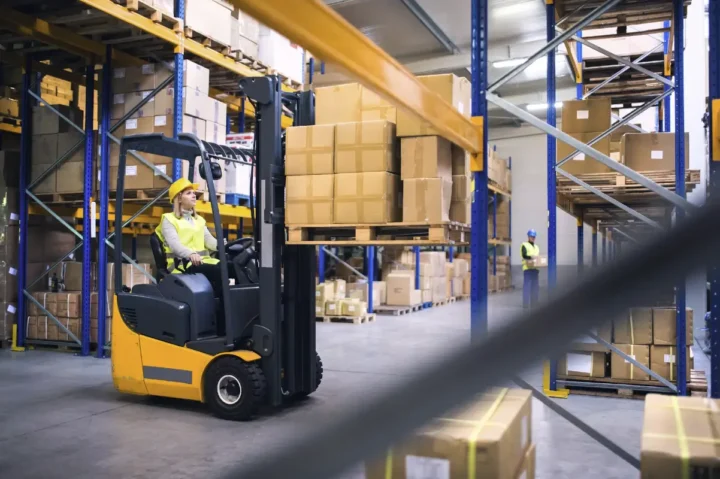Buying Your First Forklift? Here’s What Actually Matters
So, you’ve decided it’s time to buy a forklift. Maybe the old one isn’t cutting it anymore, or maybe this is your first one ever. Either way, it can be kind of confusing. There are all these types, sizes, power sources, and weird-sounding terms that make things feel more complicated than they need to be. But don’t worry. It doesn’t have to be that way.
This isn’t about memorizing forklift brands or reading a technical manual. It’s about knowing what actually matters when buying your first forklift—and how to avoid some common mess-ups people make when they rush into it.

It’s Not Just About Lifting Things
At first, a forklift might seem like just another machine to move heavy things around. But it’s more than that. The forklift you choose can totally change how fast, safe, and efficient your whole operation runs.
Think about where it’ll be used. Indoors? Outdoors? Both? On smooth concrete or rough surfaces? These things matter more than the number of buttons or how shiny it looks. For example, a forklift made for indoor warehouses with clean floors won’t work well on uneven gravel. You’ll want something more rugged for that kind of ground.
Also, consider how high it needs to lift. Some forklifts are great at moving stuff on the ground, but struggle with higher shelves. Others go way up but might be slower or harder to steer. It all depends on what you actually need it to do, not just what sounds cool.
Think Long-Term, Not Just Today
Buying a forklift isn’t just a one-time thing. It’s more like getting a new teammate who’ll be around for years. That’s why it’s smart to think beyond the day it arrives.
How often will it be used? Every day, all day? Or just now and then? If it’s going to be working hard all the time, it needs to be built tough. But if it’s only for light use once in a while, you might not need the top-of-the-line model.
This is also a good time to think about repairs and servicing. Some forklifts are easier to maintain than others. Certain brands have better support, cheaper parts, and faster service if something breaks. Nobody wants a machine sitting around broken while everything else grinds to a stop.
For those who are still figuring out where to start or want trusted help when making a purchase, a good option is to buy a forklift in Melbourne from places that offer reliable advice and ongoing support. Even if you’re not in Melbourne, looking at how a proper dealer lays out choices can help you understand what questions to ask wherever you are.
Electric or Fuel-Powered? Here’s the Deal
You’ll need to choose between electric forklifts and ones that run on fuel—usually diesel or gas.
Electric forklifts are clean, quiet, and great for indoor spaces. They don’t make fumes, and they’re cheaper to run over time. But they need to be charged, and charging can take hours. If there’s no time to wait between uses, that could be a problem unless there are backup batteries.
Fuel-powered forklifts are stronger and usually better for outdoor jobs or rougher conditions. They can run longer and just need a quick refill. But they’re louder, give off exhaust, and cost more to operate long-term.
There’s no best choice here. It depends on where and how the forklift will be used. Just don’t choose one without thinking about what the job really needs.
Size, Shape, and Turning Space
Forklifts come in all sorts of shapes and sizes. Some are small and zippy, made for tight spaces. Others are big and powerful, but harder to move around. The right size depends on where it’ll be driving.
Measure doorways, aisles, and turning corners in the space it’ll be used. If it’s too big to turn without bumping into everything, it won’t be helpful—even if it lifts a ton.
Also, check the weight limits. It’s not just about how heavy something looks. Loads that seem fine might be off-balance or shaped weird, which changes how stable the forklift feels. Buying one with a higher load rating than needed is usually a safe move. It’s better to have more power than not enough.
Operator Comfort Actually Matters
It might sound silly, but how comfy the forklift is can affect everything. If someone’s driving it for hours every day, things like the seat, visibility, controls, and steering make a big difference.
When drivers are cramped, bouncing around, or constantly adjusting mirrors just to see properly, they get tired faster and make more mistakes. A good forklift feels smooth to drive, doesn’t shake too much, and lets the driver see clearly in all directions. It also has controls that are simple to use, without needing to stretch or twist in weird ways.
Comfort isn’t about luxury—it’s about staying safe and productive.
New or Used? Both Can Be Good
Not everyone needs a brand-new forklift. Used ones can be just as good if they’ve been well taken care of. A good used forklift will cost less and still work great. Just make sure it’s inspected, serviced, and comes with some kind of warranty or support.
Brand new forklifts cost more but come with full warranties and no wear and tear. If budget isn’t super tight and the plan is to use it a lot, new might be the smarter call in the long run.
Either way, don’t just pick the cheapest option. Focus on the one that meets your actual needs and will last without constant repairs.
Take a Test Drive (Yes, Really)
Just like with a car, it helps to test a forklift before buying. Even watching someone else drive it around can help. This gives a sense of how it moves, how loud it is, and whether it feels smooth or awkward.
If possible, test it in the same kind of space it’ll be used in. Tight corners, ramps, and heavy lifting all feel different once you’re in the seat. Better to know now than be surprised later.
What Really Matters Most
In the end, buying a forklift isn’t about chasing the biggest brand or fanciest model. It’s about getting something that actually fits the job. The best forklift is one that:
- Matches the space it’s used in
- Handles the weight and height needed
- Feels safe and easy to drive
- Has good support and service options
- Fits the budget without cutting corners on the important stuff
Forget the extras that sound fancy but won’t actually be used. Focus on what’ll make daily work smoother, safer, and faster.
What to Remember
Buying your first forklift can feel like a big decision, but it doesn’t have to be overwhelming. Start by thinking about where and how it’ll be used. Don’t get distracted by stuff that doesn’t really matter day-to-day.
Choose something that fits the job, feels reliable, and will last longer than a few busy seasons. And whenever possible, get help from people who know what they’re doing—it can save time, money, and a lot of hassle later on.
Still not sure what to get? That’s normal. Just take it one step at a time and focus on what your workplace actually needs. The rest will fall into place.


